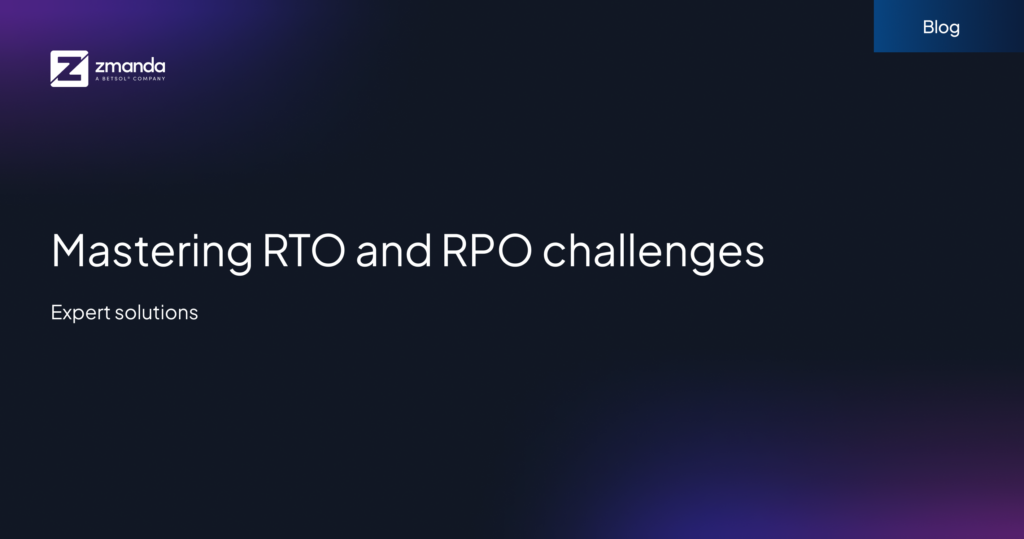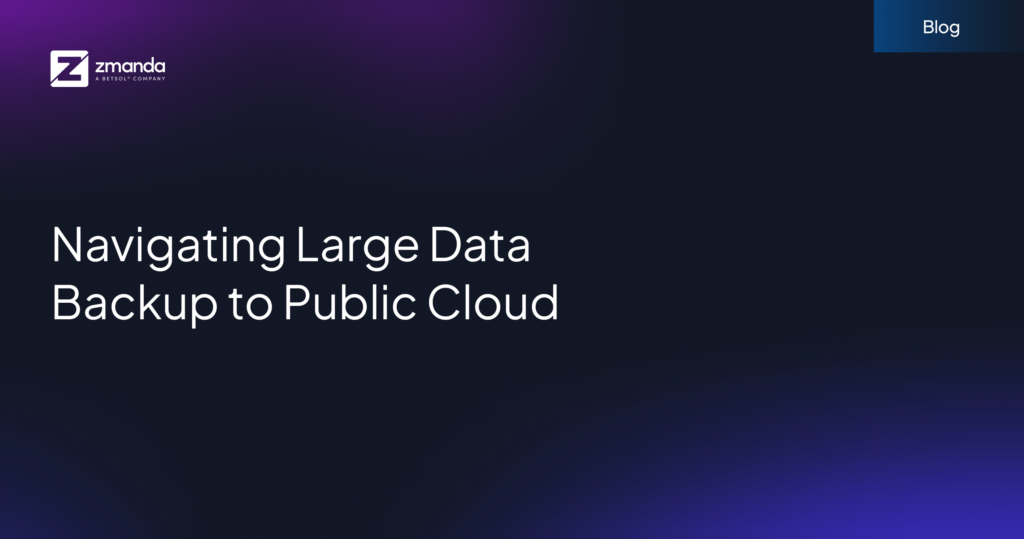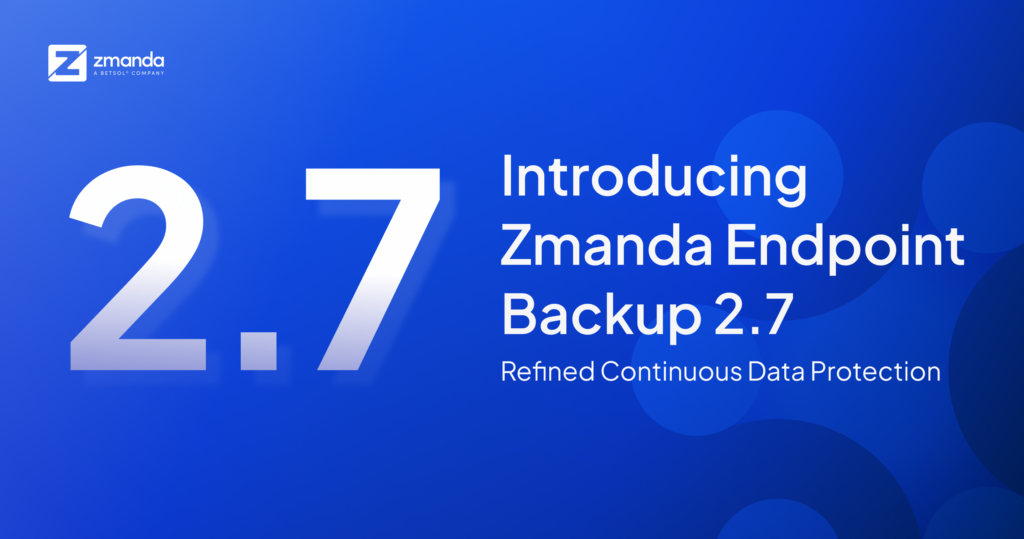
What do businesses use as a leverage point to mint revenue and profits? It’s DATA. Companies now use advanced data analytics to launch their innovative products and services in the market, improve operations, or make better decisions based on correct information. In short, data is the HEARTBEAT for businesses. So it is understandable why they go to great extents to protect it from corruption or loss. This is where robust backup and 재해 복구 (DR) strategies come into play.
역사적으로 기업들은 기존의 데이터 보호 솔루션을 채택했지만 데이터 증가, 이를 효과적으로 보호하고 정전 중에 액세스를 완전히 복구할 수 있는 능력이 점점 더 의심스러워지고 있습니다.
Failing to modernize their backup and disaster recovery (DR) strategies has cost many businesses millions. A 2015 study from EMC 그 제안 data loss and downtime cost a total of $1.7 trillion each year (실제 비용). 데이터가 디지털화되고 있기 때문에 시간이 지날수록 그 숫자는 더 늘어날 것으로 예상됩니다.
기존 백업 및 재해 복구 솔루션이 더 이상 충분하지 않은 이유와 최신 클라우드 기반 접근 방식이 비즈니스를 보호하는 보다 안정적이고 효율적인 방법을 제공하는 방법은 다음과 같습니다.
Limitations of Traditional Backup and Disaster Recovery and Their Solutions
1. 자기 매체의 부패와 폭로
여전히 테이프 백업을 배포하는 회사의 데이터 무결성에 대한 우려가 있습니다. 데이터 백업 테이프 are built with magnetic media, which is extremely vulnerable to corruption and exposure. With data backup tapes, data is usually saved to the magnetic media, and any exposure to a fingerprint or getting too close to a magnetized area, makes the data on the tape unusable, and you will only know about the corruption when you try to restore and find it isn’t there.
There seems to be a significant failure rate on magnetic media, but still, people assume the data that is stored on their tapes is safe and sound.
해결 방법 :
Fortunately, advancements in technology offer more robust and reliable alternatives to traditional tape backups.
- Cloud-Based Backup: Cloud storage offers a secure and durable platform for data backups. Data is replicated across geographically dispersed data centers, minimizing the risk of physical damage or localized outages.
- Disk-Based Backup Systems: Modern disk-based backup solutions leverage advanced error correction techniques and redundancy features to ensure data integrity. These systems also offer faster backup and restore times compared to tapes.
By transitioning away from tape backups and embracing modern solutions, organizations can significantly reduce the risk of data corruption and ensure the reliability of their backups. This translates to improved business continuity and peace of mind in the event of a disaster or data loss event.
2. Unforeseen Data Growth and Backup Capacity
One of the major hurdles with traditional backup and disaster recovery solutions is their limited scalability. Many organizations struggle to accurately predict their future data storage needs. Underestimating these needs leads to insufficient backup capacity, requiring additional investment beyond the initial setup costs.
해법: Cloud-based backup and disaster recovery solutions offer a powerful advantage in this regard – scalable storage. These solutions eliminate the need for upfront investment in physical backup infrastructure that may become inadequate as your data volume grows.
Here’s how cloud-based backup and disaster recovery addresses the challenge:
- On-Demand Scalability: Cloud storage allows you to easily adjust your storage capacity as your data needs evolve. You only pay for the storage you use, eliminating the risk of overprovisioning or underprovisioning.
- 탄력: Cloud-based solutions offer elastic storage, allowing you to scale storage capacity up or down quickly based on real-time requirements. This ensures you have the necessary backup space for data surges without unnecessary ongoing costs.
- 자동화된 관리: Cloud backup and disaster recovery solutions automate storage management tasks, freeing up your IT staff to focus on other critical initiatives. Say goodbye to manual capacity planning and reactive upgrades.
By leveraging cloud-based scalable storage, organizations can overcome the challenge of unpredictable data growth and ensure their backup and disaster recovery strategy remains adaptable and cost-effective in the face of ever-increasing data volumes.
3. Increased Vulnerability of Offsite Backup Systems to Disasters
While traditional backup and disaster recovery approaches may involve storing backups offsite to protect against local disasters, this method has limitations. What happens if the offsite facility itself is impacted by a natural disaster or other disruptive event?
- 물리적 손상: If the offsite storage unit suffers physical damage, your backups could be compromised alongside your primary data.
- 접근성 문제: Disaster situations can create logistical challenges, making it difficult to access or retrieve offsite backups promptly.
- 호환성 문제: Traditional backup methods often rely on specific hardware or software versions. Finding a compatible replacement unit for a damaged backup system in the aftermath of a disaster can be a time-consuming and frustrating task, further delaying data recovery.
해결 방법 : Cloud-based backup and disaster recovery offer a more resilient approach to disaster recovery
- Geographically Distributed Storage: Cloud storage providers replicate your data across geographically dispersed data centers. Even if one facility is impacted by a disaster, your backups remain secure and accessible in other locations.
- 고가용성: Cloud providers prioritize uptime and redundancy. Their data centers are built with robust infrastructure and disaster recovery plans to ensure your data remains accessible even in the event of an outage.
- 즉각적인 복구: Cloud-based BDR solutions enable rapid recovery from any location with an internet connection. There’s no need to wait for physical media or struggle with compatibility issues.
By adopting cloud-based backup and disaster recovery, organizations can achieve a more robust disaster recovery strategy, ensuring business continuity even when faced with unforeseen events.
4. 재해 복구의 복잡성:
Today, data protection is a high concern for today’s enterprises, businesses need to think about more than local backup and recovery, which is “재해 복구.” 때에 온다 traditional backup and disaster recovery solutions, 데이터를 복원하는 데 걸리는 복잡성과 시간으로 인해 재해 복구에 집중하는 기업의 능력을 제한합니다. 결과적으로 기업은 덜 신뢰할 수있는 재해 복구 계획을 채택하고 재해 발생시 더 큰 위험에 직면하게됩니다.
해결 방법 : Modern Backup and Disaster Recovery solutions are designed for simplicity and ease of use. They can automate disaster recovery processes, minimizing downtime and ensuring faster business continuity.
- Simplicity and Automation: These solutions are designed for ease of use with intuitive interfaces and automated workflows. This allows businesses to implement and manage their DR plan without extensive IT resources. IT staff can focus on strategic initiatives while the DR solution handles the heavy lifting.
- 향상된 신뢰성: Cloud DR solutions leverage geographically distributed data centers and redundant infrastructure. This provides greater resilience against disasters. Businesses can be confident that their data remains secure and accessible even in the face of unexpected disruptions, such as natural disasters or cyberattacks.
5. 제한된 클라우드 채택:
Businesses still clinging to traditional backup infrastructure miss out on the benefits of the cloud. This can lead to slower recovery times and limited protection for long-term data retention.
해결 방법 : Cloud-based backup and Disaster Recovery solutions leverage the power and scalability of the cloud, offering faster backups, easier disaster recovery, and secure long-term data storage. Cloud providers are dedicated to making cloud DR adoption easy and accessible for businesses of all sizes
- Simplified Cloud Onboarding: Many providers offer user-friendly interfaces and intuitive workflows for seamless cloud integration. Businesses can migrate their data and configure their DR plan without extensive technical expertise.
- 전문가 지원 및 안내: Cloud providers offer comprehensive support services, including migration assistance, training, and ongoing technical assistance. This ensures a smooth transition and empowers businesses to leverage the full potential of their cloud DR solution.
- Hybrid Cloud Models: Hybrid cloud DR allows businesses to integrate their existing on-premises infrastructure with the cloud. This approach provides a familiar starting point and simplifies the migration process for organizations with legacy investments.
6. 느린 복구
Traditional recovery time ranges from a couple of days to weeks, and to restore the last known state of the data center, each server node has to be re-initiated, with tedious installations of the base operating system and the entire application software, including all updates and patches. Additionally, the entire network configuration has to be restored to match the original settings, including VLANs, VPNs, DNS, and firewall rules. After doing all this, the actual backup can be loaded, either incrementally or at once including all user accounts, databases, documents, and other elements in their latest state. In case, if the last backup was done several days or weeks ago, recovery can become a long and time-consuming process.
According to EMC, “For each hour of downtime, organizations tend to lose thousands of dollars. On average, businesses experienced 25 hours of unexpected downtime, with 36% of them reporting revenue loss and 34% reporting delays in product development due to the disruptions” (Downtime and Data Loss).
해결 방법 : Modern backup and disaster recovery solutions offer significantly faster recovery times, minimizing downtime and associated financial losses.
- 자동화된 워크플로: Modern DR solutions automate critical recovery tasks, such as server provisioning, software installation, and configuration restoration. This eliminates the need for manual intervention and significantly reduces recovery times.
- Instant Recovery Capabilities: Cloud-based backups enable businesses to restore data and applications from a near-instantaneous point in time, minimizing downtime and ensuring a faster return to normal operations.
- Disaster Recovery Orchestration: Advanced cloud DR solutions offer orchestration capabilities that automate the entire recovery process, including network configuration, security settings, and application dependencies. This ensures a smooth and efficient recovery.
Modern Backup and Disaster Recovery Solutions with Zmanda
Protecting your data is equivalent to protecting money, it needs to be held somewhere really secure where you can easily access it in case of emergency. We know a secure place for money is the bank and similarly, for data, it is in the cloud. Cloud backup and Disaster Recovery solutions are more reliable, fast, and secure than traditional backup solutions. Zmanda 프로 is an all-in-one solution for backup and disaster recovery that protects files, servers, and entire data centers. This modern solution is designed for companies that have an extremely low tolerance for data loss, downtime, or risk mitigation. Want to take a free trial with Zmanda? 시작하기.
체크 아웃해야합니다. 재해 복구 계획에 포함 할 사항


